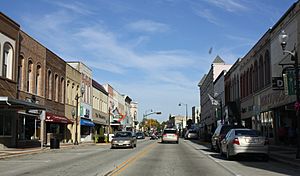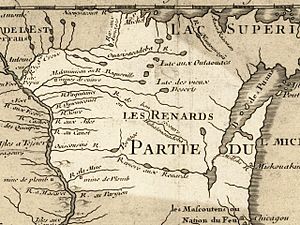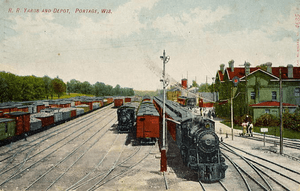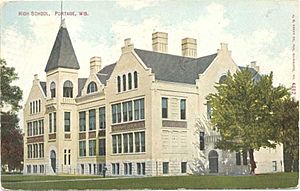Portage, Wisconsin facts for kids
Quick facts for kids
Portage, Wisconsin
|
|
|---|---|

Downtown Portage
|
|
| Motto(s):
"Where the North Begins"
|
|

Location of Portage in Columbia County, Wisconsin
|
|
| Country | |
| State | |
| County | Columbia |
| Settled | 1851 |
| Area | |
| • Total | 9.71 sq mi (25.14 km2) |
| • Land | 8.91 sq mi (23.07 km2) |
| • Water | 0.8 sq mi (2.07 km2) |
| Elevation | 794 ft (242 m) |
| Population
(2020)
|
|
| • Total | 10,581 |
| • Estimate
(2019)
|
10,399 |
| • Density | 1,167.51/sq mi (450.8/km2) |
| Time zone | UTC-6 (Central (CST)) |
| • Summer (DST) | UTC-5 (CDT) |
| ZIP Code |
53901
|
| Area code(s) | 608 |
| FIPS code | 55-64100 |
| GNIS feature ID | 1571799 |
| Website | www.portagewi.gov |
Portage is a city located in Columbia County, Wisconsin, in the United States. It is the main city and the county seat of Columbia County. This means it's where the county government offices are. In 2020, about 10,581 people lived here, making it the biggest city in the county. Portage is also part of the larger Madison metropolitan area.
The city got its name from a special place called the Fox–Wisconsin Waterway. This was a "portage" (a place where boats and goods had to be carried over land) between the Fox River and the Wisconsin River. Explorers Jacques Marquette and Louis Joliet discovered this route in 1673 while looking for a way to the Mississippi River. Portage's slogan is "Where the North Begins."
Contents
History of Portage

Long ago, Native American tribes lived in this area. Later, European traders and settlers came. They all used the low, flat land between the Fox and Wisconsin Rivers as a natural "portage." This was a shortcut where they could carry their canoes and supplies from one river to the other. The Menominee tribe called this place Kahkāmohnakaneh, which means "at the short cut."
In May 1673, Jacques Marquette and Louis Jolliet, a French-Canadian explorer, set out to find the Mississippi River. They traveled up the Fox River. Near its source, they were told to carry their canoes about two miles through marshy land to reach the Wisconsin River. French fur traders later called this spot "le portage," which is how the community got its name.
Because it was a portage, this area became a busy place for trade. A canal was later built to make trade even easier. When railroads arrived, Portage continued to be an important center for moving goods.
Portage grew because of its unique location. It was on a one-and-a-half-mile strip of land between the Fox and Wisconsin Rivers. By the late 1600s, the Fox-Wisconsin waterway, connected at Portage, was the main route for fur trading. Traders built warehouses here in the late 1700s. In the early 1800s, many Métis (people of mixed Native American and European heritage) lived in Portage.
In 1828, the government saw how important Portage was for trade. They built Fort Winnebago at the Fox River end of the portage. In 1851, Portage became the county seat of Columbia County. The community officially became "Portage City" in 1854.
The main business area of Portage is on a hill overlooking the Portage Canal. The buildings downtown were once part of a busy trading center. This area grew a lot between the end of the American Civil War and the early 1900s.
Historic Places to Visit
Portage has many interesting historic sites. These places help tell the story of the city's past:
- Fort Winnebago Surgeon's Quarters Historic Site
- Fox-Wisconsin Portage Site
- Henry Merrell House
- Old Indian Agency House
- Portage Industrial Waterfront Historic District
- Portage Retail Historic District
- Zona Gale House
- Museum at the Portage
- Wisconsin American Legion Museum and Learning Center
- Portage Canal Society
- Historic Portage Canal
- World War II History Museum
There are also many Wisconsin State Historical Markers in Portage. These markers are like outdoor signs that tell you about important events or people from history. Some of them include:
- Fort Winnebago Surgeon's Quarters Historic Site
- Frederick Jackson Turner
- Jacques Marquette
- Jacques Marquette and Louis Jolliet
- Ketchum's Point
- Potter's Emigration Society
- Society Hill Historic District
- Zona Gale
You can also find memorials for veterans and markers from the Daughters of the American Revolution.
Geography of Portage
Portage is located in the valley of the Wisconsin River. The city is surrounded by open grasslands. About three miles (5 km) west of the city are the Baraboo bluffs, which are tall hills.
The city covers about 9.62 square miles (25.14 square kilometers). Most of this is land (8.82 sq mi or 23.07 sq km), and a smaller part is water (0.8 sq mi or 2.07 sq km). As mentioned, the city's name "Portage" comes from its location between the Wisconsin and Fox rivers. Besides these rivers, the city also has access to Swan Lake and Silver Lake.
City Layout
When Portage was first built, its streets were laid out in a simple grid pattern, like a checkerboard. Today, some of the streets outside the city center are not straight. This is because of the many marshes and lowlands in Columbia County. So, the northern part of the city looks different from the central part. It has more spread-out streets and fewer homes packed together.
Portage has two main shopping areas. One is the historic downtown district, which has small, unique shops and restaurants. The other is the Northridge area, which has larger "big box" stores.
In 2007, the Portage Canal was cleaned up. Now, there's a bike path along part of it. In 2008, the main downtown street was rebuilt. Important historical places in the city include the Museum at the Portage, the Indian Agency house, and the Surgeons Quarters.
Climate
| Climate data for Portage Wastewater Treatment Plant, Wisconsin (1991–2020 normals, extremes 1896–present) | |||||||||||||
|---|---|---|---|---|---|---|---|---|---|---|---|---|---|
| Month | Jan | Feb | Mar | Apr | May | Jun | Jul | Aug | Sep | Oct | Nov | Dec | Year |
| Record high °F (°C) | 57 (14) |
72 (22) |
83 (28) |
99 (37) |
102 (39) |
104 (40) |
111 (44) |
103 (39) |
103 (39) |
93 (34) |
76 (24) |
67 (19) |
111 (44) |
| Mean maximum °F (°C) | 45.7 (7.6) |
51.7 (10.9) |
66.3 (19.1) |
77.9 (25.5) |
85.9 (29.9) |
90.8 (32.7) |
92.1 (33.4) |
90.7 (32.6) |
87.5 (30.8) |
79.9 (26.6) |
64.5 (18.1) |
50.6 (10.3) |
94.3 (34.6) |
| Mean daily maximum °F (°C) | 26.1 (−3.3) |
30.6 (−0.8) |
42.4 (5.8) |
55.7 (13.2) |
68.2 (20.1) |
77.9 (25.5) |
81.6 (27.6) |
79.9 (26.6) |
72.6 (22.6) |
59.3 (15.2) |
44.2 (6.8) |
31.8 (−0.1) |
55.9 (13.3) |
| Daily mean °F (°C) | 18 (−8) |
21.9 (−5.6) |
33.2 (0.7) |
45.8 (7.7) |
58 (14) |
67.9 (19.9) |
71.6 (22.0) |
69.6 (20.9) |
61.6 (16.4) |
49.2 (9.6) |
36.3 (2.4) |
24.4 (−4.2) |
46.5 (8.1) |
| Mean daily minimum °F (°C) | 9.9 (−12.3) |
13.2 (−10.4) |
24 (−4) |
35.8 (2.1) |
47.8 (8.8) |
57.9 (14.4) |
61.6 (16.4) |
59.4 (15.2) |
50.7 (10.4) |
39 (4) |
28.3 (−2.1) |
17.1 (−8.3) |
37.1 (2.8) |
| Mean minimum °F (°C) | −11.7 (−24.3) |
−7.8 (−22.1) |
3.2 (−16.0) |
22.4 (−5.3) |
34.1 (1.2) |
44.3 (6.8) |
51.1 (10.6) |
47.7 (8.7) |
36.5 (2.5) |
25.9 (−3.4) |
13 (−11) |
−2.6 (−19.2) |
−15.2 (−26.2) |
| Record low °F (°C) | −35 (−37) |
−37 (−38) |
−25 (−32) |
5 (−15) |
20 (−7) |
29 (−2) |
37 (3) |
33 (1) |
17 (−8) |
8 (−13) |
−10 (−23) |
−24 (−31) |
−37 (−38) |
| Average precipitation inches (mm) | 1.44 (37) |
1.41 (36) |
2.18 (55) |
4.15 (105) |
4.58 (116) |
5.61 (142) |
4.51 (115) |
4.12 (105) |
3.56 (90) |
2.86 (73) |
2.22 (56) |
1.68 (43) |
38.32 (973) |
| Average snowfall inches (cm) | 10.2 (26) |
10 (25) |
5.5 (14) |
2.2 (5.6) |
0 (0) |
0 (0) |
0 (0) |
0 (0) |
0 (0) |
0.5 (1.3) |
2 (5.1) |
8.9 (23) |
39.3 (100) |
| Average precipitation days (≥ 0.01 in) | 9.2 | 8.3 | 9.3 | 11.6 | 13.1 | 11.6 | 10.2 | 10.4 | 10.2 | 10.4 | 8.1 | 9.5 | 121.9 |
| Average snowy days (≥ 0.1 in) | 6.8 | 5.8 | 3.4 | 1 | 0 | 0 | 0 | 0 | 0 | 0.2 | 1.5 | 5.9 | 24.6 |
| Source: NOAA | |||||||||||||
Portage experiences a climate with warm summers and cold, snowy winters. The hottest month is usually July, and the coldest is January. The city gets a good amount of rain throughout the year, with more precipitation in the warmer months. Snowfall is common in winter.
Population and People
| Historical population | |||
|---|---|---|---|
| Census | Pop. | %± | |
| 1850 | 603 | — | |
| 1860 | 2,879 | 377.4% | |
| 1870 | 3,945 | 37.0% | |
| 1880 | 4,346 | 10.2% | |
| 1890 | 5,143 | 18.3% | |
| 1900 | 5,459 | 6.1% | |
| 1910 | 5,440 | −0.3% | |
| 1920 | 5,582 | 2.6% | |
| 1930 | 6,308 | 13.0% | |
| 1940 | 7,016 | 11.2% | |
| 1950 | 7,334 | 4.5% | |
| 1960 | 7,822 | 6.7% | |
| 1970 | 7,821 | 0.0% | |
| 1980 | 7,896 | 1.0% | |
| 1990 | 8,640 | 9.4% | |
| 2000 | 9,728 | 12.6% | |
| 2010 | 10,324 | 6.1% | |
| 2020 | 10,581 | 2.5% | |
| U.S. Decennial Census | |||
The population of Portage has grown steadily over the years. In 1850, there were just over 600 people. By 2020, the population had grown to 10,581.
2010 Census Information
According to the census from 2010, there were 10,324 people living in Portage. These people lived in 4,060 households. A household is a group of people living together in one home.
Most of the people in Portage (about 90.9%) were White. About 5% were African American, and smaller numbers were Native American, Asian, or from other backgrounds. About 4% of the population identified as Hispanic or Latino.
In 31% of the households, there were children under 18 living there. About 40.5% of households were married couples living together. The average age of people in Portage was 37.2 years old. About 22.1% of residents were under 18.
Education in Portage
The Portage Community School District serves the city of Portage.
Portage High School (Wisconsin) is the main high school. The old high school building is now the Wayne E. Bartels Middle School. Portage has two elementary schools: John Muir and Woodridge. There are also three elementary schools in the nearby rural areas. For private education, there are St. John's Lutheran and St. Mary's Catholic Schools. Madison Area Technical College also has a campus in Portage, offering college-level courses.
The "Portage scheme" is a special way of supporting children with special educational needs. It was first developed in this city.
Transportation and Infrastructure
Portage is easy to reach by car. Three major interstate highways, Interstate 94, Interstate 90, and Interstate 39, pass by the city. This means you can get to Madison in about 30 minutes and Wisconsin Dells in about 15 minutes. Larger cities like Milwaukee, Chicago, and Minneapolis/ Saint Paul, Minnesota are also just a few hours away.
For train travel, the Portage station offers Amtrak service. The Empire Builder train connects Chicago to Seattle or Portland, and the Borealis connects Chicago to St. Paul. This means two trains go in each direction every day. Freight trains also use the tracks, operated by the Canadian Pacific Railway.
You can also travel to Portage by bus. Intercity buses connect Portage to Milwaukee (through Madison) and to Wisconsin Rapids (through Stevens Point).
The Portage Municipal Airport (C47) serves the city and nearby communities for air travel.
Notable People from Portage
- Earl Abell, a famous football player in the College Football Hall of Fame
- Alvin Alden, a Wisconsin politician
- Walt Ambrose, an NFL football player
- Josiah D. Arnold, a Wisconsin politician
- Levi W. Barden, a Wisconsin politician
- Everett Bidwell, a Wisconsin politician
- Peter J. Boylan, a U.S. Army general
- Ben Brancel, a Wisconsin politician
- Samuel S. Brannan, a Wisconsin politician and newspaper editor
- Llywelyn Breese, a Wisconsin politician and former Secretary of State
- Guy W.S. Castle, a Medal of Honor winner
- Maureen Clark, a U.S. Olympian
- William W. Corning, a Wisconsin politician
- Luther S. Dixon, a Chief Justice of the Wisconsin Supreme Court
- Thomas E. Fairchild, a Judge of the U.S. Court of Appeals
- Russel C. Falconer, a Wisconsin politician
- Zona Gale, a writer who won the Pulitzer Prize for drama in 1921
- Charles Randall Gallett, a Wisconsin politician
- B. Frank Goodell, a Wisconsin politician
- Henry Gunderson, a lieutenant governor of Wisconsin
- Joshua James Guppey, a Union Army general
- Frank A. Haskell, a Union Army colonel and writer
- Philip Hayes, a U.S. Army general
- Charles W. Henney, a U.S. Representative
- John Edward Kelley, a U.S. Representative from South Dakota
- Herman Lange, a Wisconsin politician
- Margery Latimer, a writer
- James J. Lindsay, a U.S. Army general
- Wellington Porter McFail, an aviator
- Hugh McFarlane, a Wisconsin politician
- John Muir, a famous naturalist
- William Owen, a Wisconsin politician
- Russell W. Peterson, a former governor of Delaware
- Russ Rebholz, a football coach and Hall of Famer
- Ferdinand Schulze, a Wisconsin politician
- Mike Thompson, an NFL football player
- Yellow Thunder, a chief of the Ho-Chunk tribe
- Andrew Jackson Turner, a writer, newspaper editor, and politician
- Frederick Jackson Turner, a historian and Pulitzer Prize winner
- Samuel K. Vaughan, a Union Army general
- Joan Wade, a Wisconsin politician
- Jabez H. Wells, a Wisconsin politician
Images for kids
-
Part of the Portage Industrial Waterfront Historic District
-
Part of the Portage Retail Historic District
See also
 In Spanish: Portage (Wisconsin) para niños
In Spanish: Portage (Wisconsin) para niños














